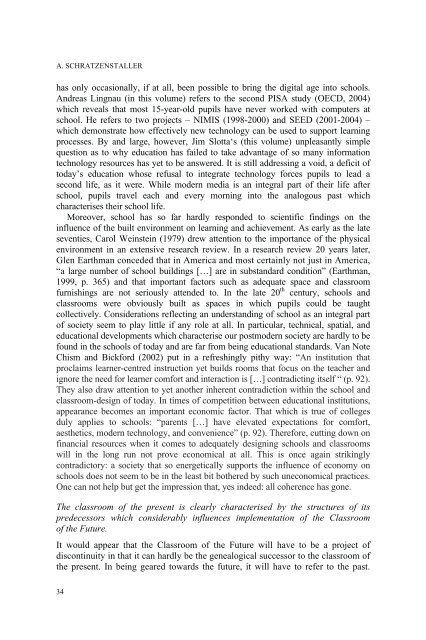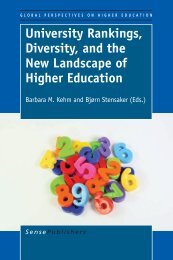Classroom of the Future - Sense Publishers
Classroom of the Future - Sense Publishers
Classroom of the Future - Sense Publishers
Create successful ePaper yourself
Turn your PDF publications into a flip-book with our unique Google optimized e-Paper software.
A. SCHRATZENSTALLER<br />
has only occasionally, if at all, been possible to bring <strong>the</strong> digital age into schools.<br />
Andreas Lingnau (in this volume) refers to <strong>the</strong> second PISA study (OECD, 2004)<br />
which reveals that most 15-year-old pupils have never worked with computers at<br />
school. He refers to two projects – NIMIS (1998-2000) and SEED (2001-2004) –<br />
which demonstrate how effectively new technology can be used to support learning<br />
processes. By and large, however, Jim Slotta‘s (this volume) unpleasantly simple<br />
question as to why education has failed to take advantage <strong>of</strong> so many information<br />
technology resources has yet to be answered. It is still addressing a void, a deficit <strong>of</strong><br />
today’s education whose refusal to integrate technology forces pupils to lead a<br />
second life, as it were. While modern media is an integral part <strong>of</strong> <strong>the</strong>ir life after<br />
school, pupils travel each and every morning into <strong>the</strong> analogous past which<br />
characterises <strong>the</strong>ir school life.<br />
Moreover, school has so far hardly responded to scientific findings on <strong>the</strong><br />
influence <strong>of</strong> <strong>the</strong> built environment on learning and achievement. As early as <strong>the</strong> late<br />
seventies, Carol Weinstein (1979) drew attention to <strong>the</strong> importance <strong>of</strong> <strong>the</strong> physical<br />
environment in an extensive research review. In a research review 20 years later,<br />
Glen Earthman conceded that in America and most certainly not just in America,<br />
“a large number <strong>of</strong> school buildings […] are in substandard condition” (Earthman,<br />
1999, p. 365) and that important factors such as adequate space and classroom<br />
furnishings are not seriously attended to. In <strong>the</strong> late 20 th century, schools and<br />
classrooms were obviously built as spaces in which pupils could be taught<br />
collectively. Considerations reflecting an understanding <strong>of</strong> school as an integral part<br />
<strong>of</strong> society seem to play little if any role at all. In particular, technical, spatial, and<br />
educational developments which characterise our postmodern society are hardly to be<br />
found in <strong>the</strong> schools <strong>of</strong> today and are far from being educational standards. Van Note<br />
Chism and Bickford (2002) put in a refreshingly pithy way: “An institution that<br />
proclaims learner-centred instruction yet builds rooms that focus on <strong>the</strong> teacher and<br />
ignore <strong>the</strong> need for learner comfort and interaction is […] contradicting itself “ (p. 92).<br />
They also draw attention to yet ano<strong>the</strong>r inherent contradiction within <strong>the</strong> school and<br />
classroom-design <strong>of</strong> today. In times <strong>of</strong> competition between educational institutions,<br />
appearance becomes an important economic factor. That which is true <strong>of</strong> colleges<br />
duly applies to schools: “parents […] have elevated expectations for comfort,<br />
aes<strong>the</strong>tics, modern technology, and convenience” (p. 92). Therefore, cutting down on<br />
financial resources when it comes to adequately designing schools and classrooms<br />
will in <strong>the</strong> long run not prove economical at all. This is once again strikingly<br />
contradictory: a society that so energetically supports <strong>the</strong> influence <strong>of</strong> economy on<br />
schools does not seem to be in <strong>the</strong> least bit bo<strong>the</strong>red by such uneconomical practices.<br />
One can not help but get <strong>the</strong> impression that, yes indeed: all coherence has gone.<br />
The classroom <strong>of</strong> <strong>the</strong> present is clearly characterised by <strong>the</strong> structures <strong>of</strong> its<br />
predecessors which considerably influences implementation <strong>of</strong> <strong>the</strong> <strong>Classroom</strong><br />
<strong>of</strong> <strong>the</strong> <strong>Future</strong>.<br />
It would appear that <strong>the</strong> <strong>Classroom</strong> <strong>of</strong> <strong>the</strong> <strong>Future</strong> will have to be a project <strong>of</strong><br />
discontinuity in that it can hardly be <strong>the</strong> genealogical successor to <strong>the</strong> classroom <strong>of</strong><br />
<strong>the</strong> present. In being geared towards <strong>the</strong> future, it will have to refer to <strong>the</strong> past.<br />
34














